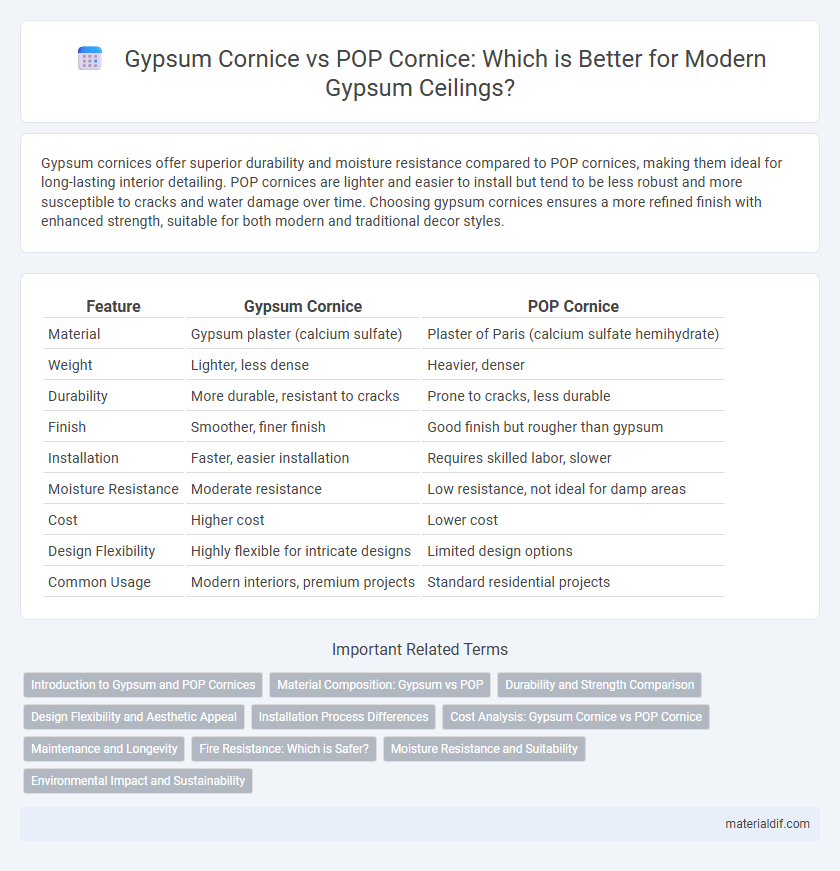Gypsum cornices offer superior durability and moisture resistance compared to POP cornices, making them ideal for long-lasting interior detailing. POP cornices are lighter and easier to install but tend to be less robust and more susceptible to cracks and water damage over time. Choosing gypsum cornices ensures a more refined finish with enhanced strength, suitable for both modern and traditional decor styles.
Table of Comparison
| Feature | Gypsum Cornice | POP Cornice |
|---|---|---|
| Material | Gypsum plaster (calcium sulfate) | Plaster of Paris (calcium sulfate hemihydrate) |
| Weight | Lighter, less dense | Heavier, denser |
| Durability | More durable, resistant to cracks | Prone to cracks, less durable |
| Finish | Smoother, finer finish | Good finish but rougher than gypsum |
| Installation | Faster, easier installation | Requires skilled labor, slower |
| Moisture Resistance | Moderate resistance | Low resistance, not ideal for damp areas |
| Cost | Higher cost | Lower cost |
| Design Flexibility | Highly flexible for intricate designs | Limited design options |
| Common Usage | Modern interiors, premium projects | Standard residential projects |
Introduction to Gypsum and POP Cornices
Gypsum cornices are crafted from natural mineral gypsum, known for their lightweight, fire-resistant properties and smooth finish, making them ideal for intricate designs and modern interiors. POP (Plaster of Paris) cornices, derived from heated gypsum powder mixed with water, offer quick setting and easy molding, allowing for versatile decorative patterns but tend to be less durable and more prone to moisture damage compared to gypsum cornices. Both materials are extensively used in ceiling decoration, with gypsum cornices preferred for longevity and premium aesthetics, while POP cornices are favored for cost-effectiveness and rapid installation.
Material Composition: Gypsum vs POP
Gypsum cornices are primarily made from natural mineral gypsum, which provides a dense, fire-resistant structure with excellent sound insulation properties. POP (Plaster of Paris) cornices are created by heating gypsum to remove water content, resulting in a fine powder that forms a lightweight, smooth finish but is less durable and more prone to moisture damage. The inherent differences in composition influence the strength, longevity, and application suitability between gypsum and POP cornices.
Durability and Strength Comparison
Gypsum cornices exhibit superior durability compared to POP cornices due to their resistance to cracks and moisture damage, making them ideal for long-term use in both residential and commercial settings. The inherent strength of gypsum material ensures better load-bearing capacity and structural integrity, whereas POP cornices, made from plaster of Paris, tend to be more fragile and susceptible to chipping under physical stress. Therefore, gypsum cornices offer enhanced robustness and longevity, outperforming POP in strength and durability metrics.
Design Flexibility and Aesthetic Appeal
Gypsum cornices offer greater design flexibility with intricate patterns and customized shapes, enhancing aesthetic appeal through smooth finishes and durable texture. POP cornices provide a lightweight option with easier installation but have limited design options and are prone to cracking over time. Gypsum's versatility and refined appearance make it ideal for sophisticated interior decor, surpassing POP in both elegance and longevity.
Installation Process Differences
Gypsum cornice installation involves fixing pre-formed gypsum moulds directly onto walls or ceilings using adhesive or screws, requiring minimal wet plastering and allowing for quicker drying time. POP (Plaster of Paris) cornices are created by applying a wet plaster mixture onto surfaces, which then needs to be carefully shaped and smoothed before drying, resulting in longer installation and curing periods. Gypsum cornices offer cleaner, more precise edges with less mess, while POP cornices provide greater flexibility for custom designs but involve a more labor-intensive installation process.
Cost Analysis: Gypsum Cornice vs POP Cornice
Gypsum cornice generally costs more upfront than POP (Plaster of Paris) cornice due to higher material and installation expenses, but it offers greater durability and resistance to cracks, potentially lowering long-term maintenance costs. POP cornice is more budget-friendly for initial installation but can incur higher repair costs over time because it is more prone to damage and moisture absorption. Considering lifecycle costs, gypsum cornices provide better value for projects prioritizing longevity and minimal upkeep.
Maintenance and Longevity
Gypsum cornices offer superior durability and require less maintenance compared to POP cornices due to their resistance to cracks and water damage. POP cornices are prone to chipping and discoloration over time, necessitating frequent repairs and repainting. The longer lifespan of gypsum cornices makes them a cost-effective choice for maintaining a pristine ceiling finish.
Fire Resistance: Which is Safer?
Gypsum cornices exhibit superior fire resistance compared to POP cornices due to their inherent composition that contains chemically bound water, which helps retard fire spread. POP cornices, although lightweight and moldable, tend to ignite quicker and lose structural integrity under high temperatures. Choosing gypsum cornices enhances safety by providing durable, fire-retardant architectural detailing ideal for residential and commercial buildings.
Moisture Resistance and Suitability
Gypsum cornices exhibit superior moisture resistance compared to POP cornices, making them highly suitable for humid or wet environments such as bathrooms and kitchens. POP (Plaster of Paris) cornices tend to absorb moisture more readily, leading to quicker deterioration and reduced durability. Therefore, gypsum cornices are preferred in areas prone to moisture, ensuring longevity and maintaining aesthetic integrity.
Environmental Impact and Sustainability
Gypsum cornices have a lower environmental impact than POP (Plaster of Paris) cornices due to gypsum's natural abundance and recyclability, reducing waste and energy consumption during production. POP cornices often involve more energy-intensive processing, emitting higher levels of carbon dioxide and generating non-biodegradable residues. Choosing gypsum cornices promotes sustainability through reduced carbon footprint, eco-friendly sourcing, and enhanced potential for reuse in construction applications.
Gypsum cornice vs POP cornice Infographic

 materialdif.com
materialdif.com